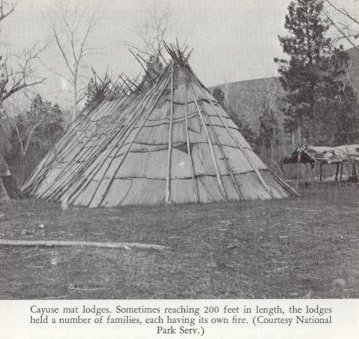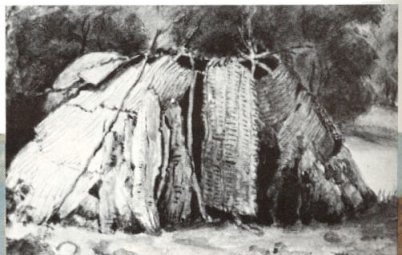
COASTAL TRIBES:
The tribal dwellings varied according to the climate and the extent
to which the tribe traveled. Since the coastal tribes moved about very
little, their dwellings were more permanent. Because the inland tribes
were often on the move in search of food, their homes were crudely built
of mud, sod, and willow branches, or they were portable shelters made
of skins or reeds.
In 1805 Lewis and Clark came upon a Chinook village near The Dalles. The village contained the first wooden structures they had seen since leaving Illinois. These houses were built 6 feet into the ground and 1 1/2 feet above ground. Each measured about 20 X 30 feet and had a gabled roof and a door at one end. Half of the house provided storage space for the dried fish, berries, and other food that had been preserved for winter use. The half near the door was the living area which was shared by three or four families.
The long houses of the coastal Indians were built of cedar planks split from the trunks of large trees. Each house measured from 40 to 100 feet in length and from 14 to 20 feet in width. The roof was usually a shed at one end, but there were no windows. These long houses usually sheltered several families, and often, an entire village. Each family had its own area with bunks against the walls and a "family room" between the sleeping area and the fire pit.
The floor was hard packed earth, but the Indian women made rush mats to use as floor coverings. (The number of mats that were owned was one measure of wealth among the coastal tribes.) The beds were woven out of beaten cedar bark or rushes. Blankets were woven from animal fur combined with beaten cedar bark. Some tribes kept a special breed of dog with thick, woolly hair. They cut the hair several times a year, combined it with cedar bark to make a yarn which they used to weave their blankets. They also used the down from ducks and geese and the wool from mountain sheep and goats to make their yarn.
INLAND TRIBES:
Inland tribes carried their houses with them or built temporary ones
of earth and sod or grass. The portable tepees were made of buffalo
hides sewn together. The average tepee used seven or eight hides and
larger ones used as many as twenty. They were frequently decorated with
designs which depicted important events in the lives of the occupants.
On hunting trips the inland tribes sometimes lived in caves in rocky
canyon walls. The homes they built for winter use were round and dome-
shaped. They consisted of a framework of slender willows covered with
sod and grass.

